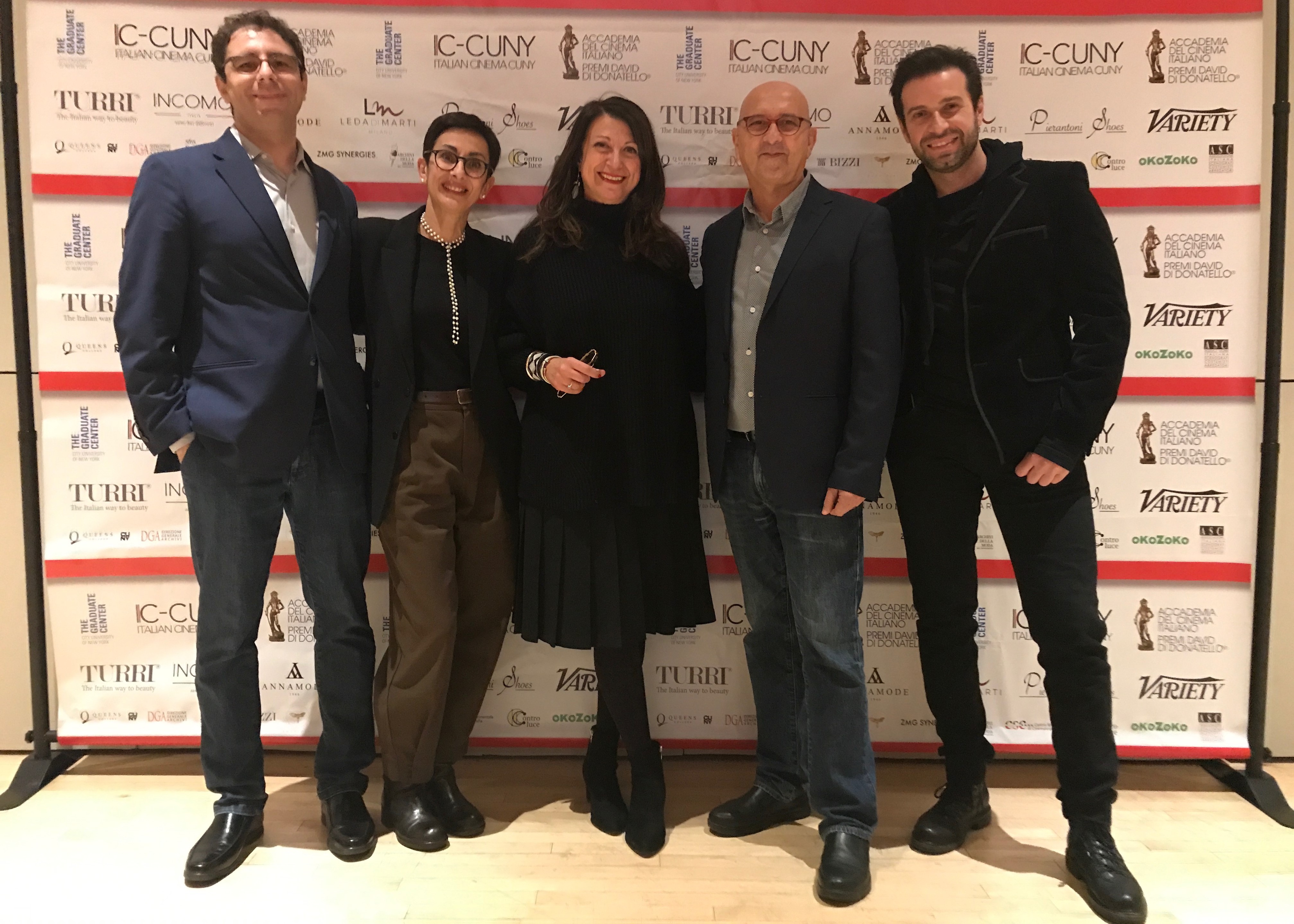
 Patricia Gatto Puglia
Patricia Gatto Puglia
Italian lifestyle and fashion: Costumes make the magic IC-CUNY Italian cinema festival wraps up in New York
- WTI Magazine #122 Dec 14, 2019
-

 Patricia Gatto Puglia
Patricia Gatto Puglia
Certain images from films just don’t fade from memory. Take, for example, actor Toni Servillo playing the jaded Jep Gambardella, king of Rome’s nightlife, in Paolo Sorrentino’s Oscar-winning The Great Beauty. Who could forget his above-it-all gaze and supple yellow sports jacket that screamed Neapolitan elegance? Then there’s the mysterious scaled creature in Guillermo del Toro’s Oscar-winning The Shape of Water. It drew you into the magic of the story and didn’t let go.
If you happened to be in New York City on December 5, you would have been treated to a conversation among the design talents who worked on these costumes. The occasion was the third Master Class on the crafts of the cinema, the final leg of the three-part IC-CUNY (Italian Cinema – City University of New York) festival spearheaded by Eugenia Paulicelli, the founder and director of IC – CUNY, professor of Italian Studies, and a scholar of fashion and film. The series was organized in collaboration with The Academy of Italian Cinema David di Donatello Awards and The Office of Academic Initiatives and Strategic Innovation at The Graduate Center, CUNY. Paulicelli said she is thankful that CUNY has embraced and intends to build upon the Italian cinema project, the 2019 event being the second edition of an Italian cinema festival held at CUNY in 2017. “This kind of academic festival showcases the cultural heritage of Italian cinema within the broader context of global cinema and media. We look forward to building on the momentum we have achieved.” The festival was held at both CUNY Graduate Center and CUNY’s Queen College.
The festival unfolds in three Master Classes
The first Master Class in October featured Italian and American award-winning costume design greats Ann Roth, Carlo Poggioli and Donna Zakowska talking about the impact that films and costumes have on our society, fashion and culture.
The November class focused on contemporary Italian films, including the screening of Una storia senza nome (The Stolen Caravaggio) directed by Roberto Ando’. The screenwriter Angelo Pasquini was on stage with Antonio Falduto, president of Controluce, to answer questions about the 2018 film, including the genesis and intricacies of the plot. The film is a story within a story. The centerpiece is the unsolved theft of Caravaggio’s Nativity in Palermo in 1969, which Pasquini set within the contemporary story of a young female secretary of a film producer who wrote scripts anonymously for a successful screenwriter who hasn’t written an original word in years. The secretary is given inside information about the painting heist from a mysterious older man who wants her to focus her script on the crime. The themes of duality of identity and purpose were talking points during the discussion.
Third and final Master Class
December’s class was themed around the intersections between fashion and costume in cinema, theater and television, presented in three parts.
First, a conversation with the principal women’s draper for the Metropolitan Opera, Siobhan Nestor, facilitated by costume designer and costume historian, CUNY Hunter College professor Deepsikha Chatterjee. Next came a video series screening and discussion focused on the Made in Italy concept. And finally, a conversation with two design stars, Italian costume designer Daniela Ciancio (The Great Beauty, Il divo, Il resto di niente, A Face of an Angel) and costume design artist Christian Cordella (Spiderman Homecoming, Logan, Into the Woods, Avenger, The Hunger Games, The Shape of Water, The Sisters Brothers).
Inside the Metropolitan Opera
Just in case you take the costumes on the stage of the Met or at the NYC Ballet for granted (Nestor was the principal men’s draper at the ballet before moving to the Met), think again. A small army of well-trained creatives and technicians is behind every stitch. Nestor explained that costume design has a critical costume construction component at its core – that’s where her particular skills come into play. Nestor said that the fact that “clothing is like putting together a puzzle” is what drew her to the profession to begin with. She characterizes herself as “methodical and logical,” certainly creative, but not necessarily “an ideas person,” someone who “executes other people’s visions” and helps the magic come alive on stage.
Made in Italy
Nestor couldn’t emphasize enough the importance of process and teamwork in costume design and production – in fact, this was a consistent refrain in the comments of all the designers at the Master Class. The idea also ran through the commentary in the video portraits of iconic Italian fashion and costume houses and personalities in the The New Made in Italy: 21st Century Fashion, Film, Arts & Design (trailer) series screened in the session. Eugenia Paulicelli and Massimo Mascolo (co-director of the 2019 IC-CUNY cinema festival) introduced the series they created with Claudio Napoli.
Segments screened at the session were of Anna Fendi, telling the story of her family’s atelier, now a fashion powerhouse; the story of Pierre (Pietro) Cardin as told by the nephew (Rodrigo Basilicati) of the 97-year-old fashion design icon who was born near Venice; and the story of the legendary Farani Sartoria workshops and archives in Rome’s Trastevere, the enterprise now directed by Luigi Piccolo. Farani was the preferred costume house of Fellini, Pasolini and costume designer Danilo Donati. A video on Neapolitan menswear designer Cesare Attolini was screened at second Master Class in November. Attolini produced the wardrobe for Servillo in The Great Beauty.
The idea, said Paulicelli, is to use the video profiles to disseminate the history and modern reality of Italian style and to frame Italy in a broader context, including its excellence in business and entrepreneurship. Ultimately, Paulicelli and her collaborators would like to produce more portraits and to see them incorporated into university and other school settings to tell the story of Italy and its interconnections in the world.
Massimo Mascolo pointed to the role family played in the stories they have chronicled so far, particularly Fendi’s story, in which five sisters worked together to build on what their parents had begun, having learned their own craft from their families.
Enter designers Ciancio and Cordella
The advantage of handing down a craft or artistic passion through the generations was also cited by Christian Cordella. His personal connection to the arts was formed and informed by his family’s history in tailoring and fashion since the late 18th century. He is a native of Lecce in Puglia and the eighth generation of Cordellas to work in the arts. He developed a sensibility for art as well as the practicality of design (what works, what does not in a costume concept) which he carries over into his current work. His role as a costume concept artist is to support and draw out the ideas of costume designers to support their ideas, including directors and producers, and help them to figure out the look of characters, which, in the case of Cordella, have included more than one alien being.
When you talk aliens, there really isn’t an actual precedent. There is, however, a lot of blue-sky thinking involved in figuring out how an alien might look and what the character wears. Pointing to an image on the screen, Cordella said: “We all know that this is a yellow t-shirt, but when we have an alien who lives on a planet made of water, all of a sudden the boundaries of what we think it is become blurry. There are so many possibilities when you have a different universe, a different planet, a character you have never seen.” His job is to organize the thoughts of the costume designer, director and often the producers as well (budget is always a concern). He then draws, takes feedback, draws again, and the character is born. Teamwork happens at every stage; there’s a process.
Technology is a key component of Cordella’s work; he said he can hardly imagine working without computer tools to produce sketches and design variations being requested with greater and greater speed. “Without computers we could not keep up.” CGI software is of course an important tool for Cordella, but he said it doesn’t completely eliminate the need to build real costumes. “The more “real” an image is, the more credible the experience.”
Daniela Cianco, like Cordella, is a proponent of following through on the steps of the process to get to the end result that creates the magic for the viewer. Ciancio, who got her start in theater and opera in Naples, begins every assignment with deep research into the period, whether it is a historical or contemporary film. She is also a sketcher at heart: “I need to draw to think. I visualize through my drawing.” She does it by hand, in the way she was trained to think and draw by the legendary costume designer, the late Piero Tosi, a master of period costumes. Ciancio recalled that when she studied with him at the Centro Sperimentale di Cinematografia in Rome, research was done through sketches; each morning she arrived with a stack of drawings that were the result of her research the previous day.
Ciancio says a critical part of her job is to find the right “shape” for the actor – physically and to support the character’s role. She quickly pivots to her costume design choices for Toni Servillo in The Great Beauty: “The shoes with two colors, the natural colored trousers, the yellow jacket… I used the idea of Neapolitan elegance in my choices. When Toni put everything on, he said, ‘OK, now I can use the cigarette in this way...’ It all worked together.” Prior to The Great Beauty, she had dressed Servillo for his role as the Italian politician Giulio Andreotti in the Paolo Sorrentino film Il divo. Andreotti was a hunchback and also a very different personality than Jep in The Great Beauty. “I needed to change Toni’s shape completely, to adjust his shirt collar height so his neck would look shorter, to use a pattern from the 1940s for his suit to adjust for the size of the shoulders. That’s why understanding how a pattern works is so important for the costume designer – we can be working with the same actor, same body, but completely different body type in each role. (A note that Servillo plays another politician, Berlusconi in the film Loro.)
For Ciancio, the fitting of the costume is the magical moment of the costume design experience, the point when “everything comes together.” Every designer who took part in the Master Classes concurred.